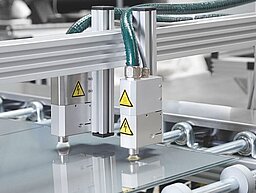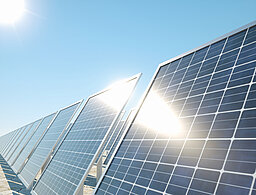Openair-Plasma® for better performance and long-term efficiency of solar energy systems
The solar radiation of the sun is available in abundance as an energy source. The total energy radiated onto the surface of the earth could meet humanity’s energy requirements seven thousand times over. (Source: Volker Quaschning, Regenerative Energy Systems, Hanser Verlag, Munich).
In recent decades, intensive work has been done on solar technology to make it usable in solar energy systems. Two main approaches can be distinguished: solar thermal energy and photovoltaics.
The solar modules, collectors and technology installed in solar energy systems are exposed to weathering around the clock. That means these elements must be protected especially against environmental influences – like humidity and temperature fluctuations. Especially in the sunniest areas on earth, there are extreme temperature differences between day and night. This puts high demands on the protection and on secure, long-term sealing of cables, modules and converters.
The high material quality achieved with Openair-Plasma® treatment produces the best prerequisites for highly efficient use of solar technology:
- Plasma activation makes it possible to manufacture weather-resistant solar modules with the use of adhesive bonding that is absolutely reliable, watertight and has long-term stability (photovoltaics).
- With the plasma coating in the PlasmaPlus® process, solar thermal mirrors in solar energy systems can be reliably provided with a glass-like corrosion protection coating (solar thermal energy).
- With plasma polymer nanocoating (plasma polymerization), surfaces of solar modules can be provided with functional characteristics in selected areas, e.g.:
- Better transmission (less reflection)
- Protection against the formation of biofilms (moss and algae growth)
- Ultrahydrophobic anti-adherent coating (protection against soiling)


Photovoltaics: Plasma bonding provides for weather-resistant solar modules with long-term stability
A photovoltaic system consists of photovoltaic modules (solar modules), which in turn consist of individual solar cells. The conversion of sunlight into electrical current takes place in these cells. There are different types of solar cells (monocrystalline, polycrystalline or thin-film solar cells).
Above all, however, there are great qualitative differences between the modules of different manufacturers with regard to service life and efficiency. These stem from the manufacturing process and the quality of the materials used.
It is not unusual for photovoltaic modules to be damaged by weathering processes; the performance of the solar cells is diminished rapidly by the penetration of moisture (moisture diffusion).
To prevent this from happening, the plasma nozzles can be easily integrated into new or existing manufacturing lines. This system is distinguished by high process reliability, short cycle times, and high processing speeds.


Increasing the quality of photovoltaic-solar modules using Openair-Plasma® pretreatment:
- Increase in the wettability of the cover glass
- Clean contact surfaces for durable and diffusion-resistant bonding
- Watertight sealing and bonding of the junction box on the reverse side (J-Box)
- High-strength bonding of the solar modules to frame and back rail
- Reliable anti-corrosion coating of the solar cell surface with AntiCorr nanocoating in the PlasmaPlus® process.
The plasma nozzles can be easily integrated into new or existing manufacturing lines. This system is distinguished by high process reliability, short cycle times, and high processing speeds.
Solar thermal energy: Reliable corrosion protection coating for solar thermal mirrors of solar power plants
For the concentrated production of energy from sunshine, sunlight is converted to heat on the basis of parabolic-trough technology. In centrally-located solar power plants, large mirrors with a parabolic shape are placed in long rows where they focus the sun’s radiation and concentrate it 80-fold. In the center of each mirror, a heat transfer medium is heated, which generates steam by way of heat exchangers. This steam in turn drives conventional electric turbines. Alternatively, the energy can be collected in heat accumulators and used for power generation at night.

During operation, the parabolic-trough solar mirrors are exposed to extreme environmental demands. This makes it necessary to provide the mirrors with a protective coating. But the efficiency of the entire solar power plant depends on the precise and intensive reflection performance of these mirrors. Any conventional polymer corrosion protection coating reduces this effectiveness and with it efficiency. Not so with the plasma coating in the PlasmaPlus® process: Full-surface nanocoating with an almost completely inorganic, glass-like coating material offers reliable corrosion protection with long-term stability even at high temperatures.
Solar modules with functional surfaces: enhancement with plasma coating under atmospheric pressure
The challenge in manufacturing solar cells and modules is to achieve more efficient, simpler and more cost-effective manufacturing – while still maintaining the highest quality standards. Low pressure plasma, etching and coating processes are firmly established in the manufacturing of solar cells. These process steps are very complicated and discontinuous because of long process times that have to be maintained.
Openair-Plasma® offers two high-efficiency solutions under atmospheric pressure:
1. Plasma activation of solar cells with the use of functional process gases
- Selective etching effect on wafers for controlled removal of material
- Removal of oxides using reducing plasmas (deoxidation)
2. Plasma polymerization with Openair-Plasma®:
- New potential for inline coating of solar modules
- Module surfaces can be functionalized (functional coating) in selected zones using plasma polymer coatings so that for example:
- Transmission is improved (reduced reflection)
- The growth of biofilms is prevented photocatalytically
- Surfaces are provided with ultrahydrophobic properties that
- Counteract dirt adhesion



